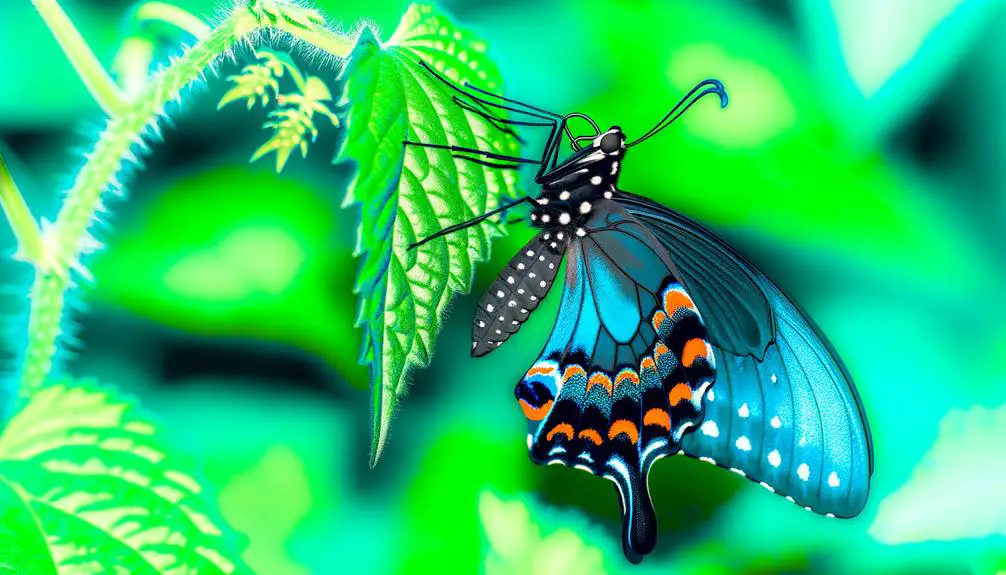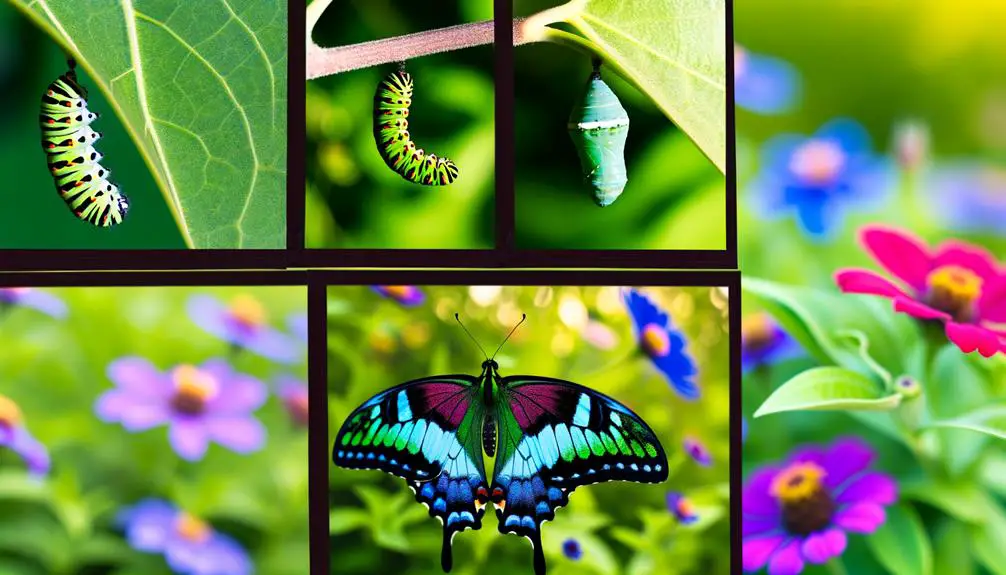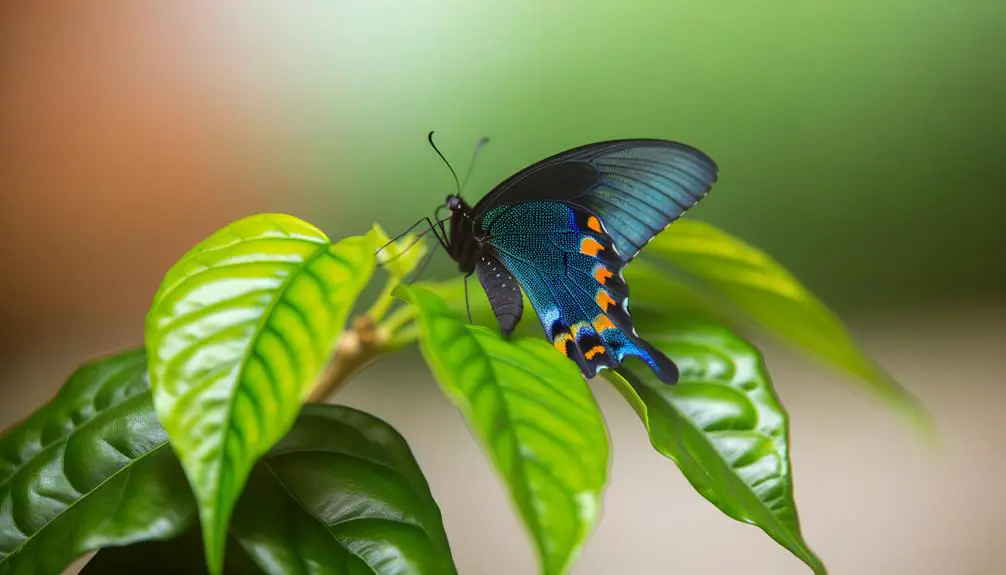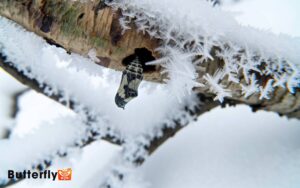What Makes the Pipevine Swallowtail a Unique Blue Butterfly?
The Pipevine Swallowtail (Battus philenor) is a enchanting butterfly distinguished by its iridescent blue-black wings and elongated tail-like extensions on the hindwings. Found mainly in the eastern United States and parts of Mexico, it thrives in regions rich with Aristolochia host plants.
This species demonstrates sexual dimorphism, with males displaying more vivid coloration. Larvae feed exclusively on Aristolochia, acquiring toxic compounds that deter predators.
Adults, on the other hand, sustain themselves on nectar from various flowers. The Pipevine Swallowtail contributes to pollination, ecosystem balance, and exhibits unique adaptations for thermoregulation and predator avoidance, revealing a complex ecological role.

Key Takeaways
- The Pipevine Swallowtail, also known as the Blue Swallowtail Butterfly, features iridescent blue-black wings with tail-like extensions.
- It is native to North America, primarily found in the eastern U.S. and parts of Mexico, thriving in regions with Aristolochia host plants.
- The butterfly exhibits sexual dimorphism, with males displaying more vivid coloration compared to females.
- Larvae feed exclusively on Aristolochia species, which contain aristolochic acids that provide chemical defenses against predators.
Identification and Appearance

The Pipevine Swallowtail Butterfly (Battus philenor) is distinguished by its iridescent blue-black wings and unique tail-like extensions on the hindwings.
The upper side of the forewings exhibits a metallic blue sheen, while the hindwings are adorned with bright, iridescent scales that create an eye-catching display.
Sexual dimorphism is evident, with females exhibiting less vivid coloration compared to males.
The ventral side features a series of orange spots set against a contrasting dark background, which serves as a warning to potential predators.
The butterfly's body is slender and covered with fine scales, complementing its striking wings.
This intricate coloration and patterning not only facilitate mate attraction but also provide a defense mechanism through mimicry and aposematism.
Natural Habitat
The Pipevine Swallowtail Butterfly (Battus philenor) mainly inhabits regions where its larval host plants, chiefly species of the Aristolochia genus, are abundant.
Its geographic distribution spans across North America, from the eastern United States to parts of Mexico.
This species exhibits specific climate adaptation traits, thriving in environments ranging from temperate woodlands to subtropical areas.
Preferred Plant Species
Aristolochia species, particularly Aristolochia macrophylla and Aristolochia tomentosa, serve as the primary host plants for the Pipevine Swallowtail butterfly in its natural habitat.
These plants contain aristolochic acids, which are toxic to most herbivores but confer a chemical defense mechanism to the butterfly's larvae. Upon ingestion, these compounds render the larvae distasteful to predators.
Observations indicate that female Pipevine Swallowtails exhibit strong oviposition preferences for these Aristolochia species, ensuring larval development in a chemically safeguarded environment.
Additionally, these plants thrive in moist, shaded areas, aligning with the butterfly's habitat preferences.
This mutualistic relationship underscores the critical role of specific host plants in the life cycle and survival strategy of the Pipevine Swallowtail butterfly.
Geographic Distribution Range
Native to North America, the Pipevine Swallowtail butterfly (Battus philenor) primarily inhabits regions ranging from the eastern United States to parts of Mexico, favoring environments that support the growth of its preferred host plants. These butterflies are often found in deciduous woodlands, meadows, and fields, particularly where Aristolochia species, their primary larval food source, are abundant. The geographic distribution is influenced by the availability of these host plants and suitable climatic conditions. Additionally, they are commonly seen in gardens and urban areas that cultivate these plants.
| Region | Habitat Characteristics |
|---|---|
| Eastern United States | Deciduous woodlands, meadows |
| Southeastern United States | Swamps, riverbanks |
| Southwestern United States | Desert edges, riparian zones |
| Central Mexico | Tropical and subtropical forests |
| Urban Areas | Gardens with Aristolochia species |
Climate Adaptation Traits
Given its extensive geographic distribution, the Pipevine Swallowtail butterfly exhibits remarkable climate adaptation traits that enable it to thrive across diverse habitats ranging from temperate woodlands to arid desert edges.
This species demonstrates physiological plasticity, with larvae capable of tolerating a broad spectrum of thermal environments. The butterfly's adult stage showcases behavioral adaptations, such as microhabitat selection, where individuals seek shaded areas to mitigate extreme heat.
Additionally, the Pipevine Swallowtail's preference for Aristolochia host plants, which are prevalent in varied climates, guarantees its reproductive success. Seasonal polyphenism is also observed, with morphological variations aligning with local climatic conditions, thereby optimizing survival rates.
These adaptive traits underscore the butterfly's resilience and ecological versatility.
Life Cycle Stages

The life cycle of the Pipevine Swallowtail Butterfly (Battus philenor) encompasses four distinct stages: egg, larva (caterpillar), pupa (chrysalis), and adult butterfly. Each stage is marked by significant morphological and physiological transformations.
Eggs are laid singly on host plants, typically Aristolochia species. Upon hatching, larvae undergo several instars, characterized by vibrant coloration and chemical defenses. The pupa stage, encased in a chrysalis, involves metamorphosis, culminating in the emergence of a striking adult butterfly.
Key points to note:
- Egg Stage: Laid on host plants, critical for initial survival.
- Larva Stage: Multiple instars with defensive adaptations.
- Pupa Stage: Metamorphosis within the chrysalis, leading to adult formation.
These stages underscore the complexity and resilience of this species' life cycle.
Diet and Feeding Habits
The Pipevine Swallowtail butterfly (Battus philenor) exhibits highly specialized feeding habits, mainly relying on Aristolochia species as its larval host plants.
Adult butterflies chiefly obtain nectar from a variety of floral sources, including milkweed, thistles, and lantanas.
This dual dependency on specific host plants for larvae and diverse nectar sources for adults highlights the intricate ecological interactions necessary for their survival and reproduction.
Preferred Host Plants
Pipevine Swallowtail butterflies exhibit a strong preference for plants in the Aristolochiaceae family, particularly species of the genus Aristolochia, which serve as both larval host plants and a primary food source.
These butterflies are highly specialized, laying eggs exclusively on Aristolochia species to guarantee larval access to essential alkaloids. The caterpillars ingest these toxic compounds, rendering themselves distasteful to predators.
Three key host plants within the Aristolochiaceae family include:
- Aristolochia macrophylla (Dutchman's Pipe)
- Aristolochia californica (California Pipevine)
- Aristolochia tomentosa (Woolly Pipevine)
The larvae's dependence on these specific plants underscores the critical role of Aristolochia in the Pipevine Swallowtail's lifecycle, highlighting a sophisticated ecological interaction that enhances survival and deters predation.
Nectar Sources
Adult Pipevine Swallowtail butterflies primarily obtain nectar from a diverse array of flowering plants, relying on these sources for sustenance and energy.
These Lepidoptera exhibit preference for flowers with high nectar content, such as milkweed (Asclepias spp.), thistle (Cirsium spp.), and lantana (Lantana spp.).
Their proboscis, a specialized feeding organ, allows efficient extraction of nectar from various floral structures.
Observations indicate that these butterflies are particularly attracted to brightly colored blooms, which serve as visual cues.
Additionally, their feeding habits play an essential role in pollination, contributing to the reproductive success of many plant species.
Seasonal variations in floral availability necessitate a broad spectrum of nectar sources, ensuring their survival across diverse habitats.
Unique Adaptations

Among its remarkable traits, the Pipevine Swallowtail Butterfly exhibits several unique adaptations that enhance its survival and reproductive success. One such adaptation is its ability to store toxic compounds from its host plant, making it unpalatable to predators. This defense mechanism not only protects the Pipevine Swallowtail but also influences mimicry in other species, as seen in the black swallowtail butterfly emergence of similar coloration for protection. Additionally, its swift and erratic flight patterns help it evade potential threats while searching for nectar and suitable egg-laying sites.
Significantly, these butterflies have evolved specific mechanisms to deter predators, optimize their life cycle, and guarantee reproductive fidelity.
- Chemical Defense: Larvae and adults sequester toxic aristolochic acids from their host plants, rendering them unpalatable to predators.
- Mimicry: The Pipevine Swallowtail's coloration mimics the unpalatable Battus philenor, reducing predation through visual deception.
- Thermoregulation: Darkly pigmented wings absorb sunlight efficiently, allowing for better temperature regulation in varying climates.
These adaptations collectively contribute to the Pipevine Swallowtail's resilience and ecological success, underscoring the sophisticated interplay between evolutionary pressures and biological ingenuity.
Role in Ecosystem
By leveraging these unique adaptations, the Pipevine Swallowtail Butterfly plays a crucial role in its ecosystem, influencing both plant and animal communities through its interactions and behaviors.
As a pollinator, it facilitates the reproduction of various flowering plants, thereby contributing to biodiversity.
The butterfly's larvae, which feed exclusively on pipevine plants, sequester toxic compounds, making them unpalatable to predators and maintaining a balance within the food web.
This toxin sequestration also deters herbivores from consuming pipevine plants, indirectly protecting these essential flora.
Moreover, the aposematic coloration of both larvae and adults serves as a warning signal, enhancing predator-prey dynamics.
Consequently, the Pipevine Swallowtail's ecological contributions underscore its integral role in maintaining the health and stability of its habitat.
Conclusion
The pipevine swallowtail, or blue swallowtail butterfly, showcases remarkable biological characteristics and ecological significance.
Significantly, the species' vibrant coloration serves as a warning to predators of its toxicity, a defense mechanism derived from its diet of toxic pipevine plants.
An intriguing statistic reveals that only 1-2% of eggs laid reach adulthood, underscoring the challenges faced during their life cycle.
The butterfly's role in pollination and as a food source for other species highlights its importance in maintaining ecological balance.






